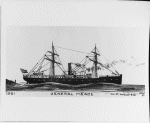Specifications:
Displacement 1,238 t.
Length 211'
Beam 21'7"
Depth of Hull 21'2"
Draft 16'8"
Speed 11 kts.
Complement 122
USS Bermuda (I)
Dictionary of American Navy Fighting Ships (DANFS)
| Back To The Navsource Photo Archives Main Page | Back To The Old Navy" Steam and Sail Index |
| Comments, Suggestions, E-mail Webmaster. |
|
This page is created and maintained by Gary P. Priolo |

